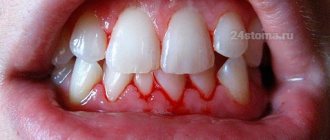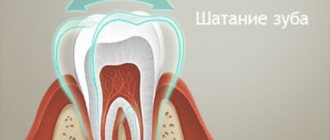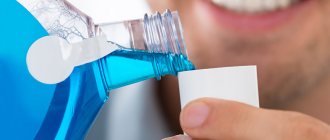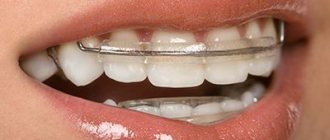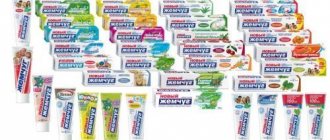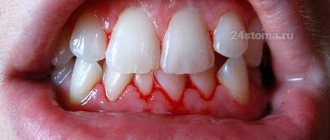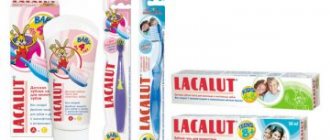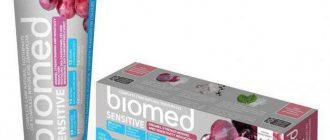From this article you will learn:
- best toothpaste for bleeding gums,
- selection of toothpastes for periodontal disease,
- Which toothpaste – Parodontax, Lacalut, etc. helps better.
The article was written by a dentist with more than 19 years of experience.
Therapeutic toothpaste for gums should contain special components that will reduce pain and bleeding when brushing your teeth, as well as a number of anti-inflammatory components. There are now a huge number of anti-inflammatory toothpastes on the market, which are very difficult for the average consumer to navigate. For example, despite the fact that all these toothpastes are positioned as “anti-inflammatory”, in fact they will act differently on such a symptom as bleeding gums.
Toothpaste for bleeding gums should first of all contain astringent components such as aluminum lactate or zinc lactate. The effectiveness of which you will notice after 1-2 applications. As for other components, anti-inflammatory toothpastes for periodontal disease usually include antiseptic chlorhexidine (0.05-0.25%), mineral salts, allantoin, bisabolol, thymol and eugenol, phenyl salicylate + medicinal plant extracts.
Bleeding gums -
One of the most famous remedies for inflammation and bleeding gums is Parodontax gum toothpaste. Below we will give detailed reviews of it, but in our rating it is far from 1st place. The rating was compiled based on an analysis of the composition of the products, as well as thanks to the 10 years of work experience of the author of the article - a periodontist (documents on advanced training of the state standard in the Periodontology program - can be viewed in the editorial section).
Also in this article we will look at the side effects of long-term use of toothpastes with antiseptics. You will be surprised, but in patients with cardiovascular pathology, they can even lead to increased blood pressure. It is also not unimportant that the use of toothpastes with sodium lauryl sulfate (SLS) is not compatible with antiseptic rinses with chlorhexidine solution. And we justify all this with references to clinical studies.
Choosing a toothpaste for gums – summary
If the main symptom of gum inflammation is bleeding, it is better to use pastes of the Lacalut and President brands, because they contain components such as aluminum lactate and zinc lactate. The latter very quickly reduce bleeding gums, but keep in mind that such toothpastes (as well as toothpastes with the antiseptic chlorhexidine) are ideally undesirable to use for more than 2 weeks. And after this period, it is worth switching to toothpaste without antiseptics and antibiotics, for example, Paradontax toothpaste.
But precisely during the period of acute manifestations, in order to quickly relieve inflammation in the gums, special gum rinses can be a good addition to anti-inflammatory toothpaste. Many of them contain high concentrations of anti-inflammatory components, which can eliminate bleeding gums even faster (than if you use only one toothpaste). Such rinses are also divided into those that can be used for a short course, and those that can be used on an ongoing basis.
Important: next, a very important point for patients who are going to use anti-inflammatory toothpaste for gums - in parallel with antiseptic mouth rinses with chlorhexidine solution. Clinical studies (source) have shown that chlorhexidine can be inactivated by the oral hygiene component sodium lauryl sulfate (SLS), which is present in most toothpastes.
This is of great importance because... rinsing the mouth with chlorhexidine solution is usually recommended after oral hygiene (morning and evening). Studies have found that after brushing your teeth with a paste containing sodium lauryl sulfate, ideally 2 hours should pass (at least 30 minutes, but this is not enough) so that lauryl sulfate does not affect the effectiveness of chlorhexidine. Therefore, if you are going to rinse your mouth with chlorhexidine at the same time, we recommend buying toothpaste without sodium lauryl sulfate (SLS).
SIGNS OF BLEEDING GUM AND PERIODONTAL DISEASE
Periodontal disease is a chronic disease of periodontal tissues, in the last stage of which the roots of the teeth are exposed. Periodontium is the soft tissue around the tooth. In the initial stage, regular gum bleeding appears when brushing your teeth. Then the teeth gradually begin to become exposed, and tooth mobility develops. These are the main signs of bleeding gums. Often due to periodontal disease develop:
- infectious diseases
- gastritis
- stomach ulcer
- cirrhosis of the liver
- teeth may fall out
Side effects of toothpastes with antiseptics -
We urge you to be careful when using toothpastes that contain the antiseptic chlorhexidine (especially if its content is 0.1% or higher). Providing an antimicrobial effect on certain types of pathogenic bacteria, chlorhexidine leads to a total change in the ratio of different types of microorganisms in relation to each other. Scientific studies (source) found that with long-term use of toothpastes with chlorhexidine, the number of bacteria in the oral cavity increased, which were characterized by more active production of lactic acid.
Accordingly, this led to an increase in the content of lactic acid in the oral fluid (saliva), and a shift in pH to the acidic side. At the same time, this led to a decrease in the buffer capacity of saliva, which reduces the ability of saliva to neutralize acids secreted by cariogenic bacteria. This is important because the acidic pH of oral fluid promotes demineralization of tooth enamel (leaching of calcium) and, accordingly, increases the risk of developing caries.
Important for patients with cardiovascular pathology –
Unfortunately, these are not all the side effects of chlorhexidine. The fact is that this antiseptic disrupts the ability of oral bacteria to convert nitrates (contained in foods) into nitrites. This bacterial activity is called “nitrate-reducing,” and it is one of the mechanisms that allows our body to maintain normal blood pressure. Nitrites produced by bacteria enter the blood, helping to lower blood pressure.
Accordingly, a decrease in the production of nitrites by oral bacteria will lead to an increase in blood pressure, which is especially dangerous for people with existing cardiovascular pathology. These data are confirmed by scientific research - “The increase in plasma nitrite after a dietary nitrate load is markedly attenuated by an antibacterial mouthwash. Nitric Oxide" (2008), authors – Mirco Govoni, Emmelie Å. Jansson, Eddie Weitzberg, Jon O. Lundberg. And if you wish (via the link above), you can familiarize yourself with this study using a browser translator.
Active ingredients in toothpastes for bleeding gums
All pastes that relieve symptoms of gum inflammation contain plant components: extracts of chamomile, sage, oak bark, tea tree, aloe, propolis, ginseng or cedar oil. In addition, they may contain antibacterial drugs (for example, triclosan - helps eliminate bacteria that provoke plaque formation) and antiseptics (chlorhexidine, phenyl salicylate). But you should use such pastes for no more than 2 weeks in a row, otherwise the microflora of the oral cavity is disrupted, and beneficial bacteria die along with pathogenic ones.
Important instructions for use –
The cause of gum inflammation is soft microbial plaque and hard dental deposits.
If you decide to reduce inflammation in the gums only with the help of toothpaste (without removing plaque from the dentist), you will only get a temporary effect. You should not use toothpastes for inflammation in the gums or for bleeding gums on an ongoing basis, because they only mask the symptoms of inflammation. And in fact, the inflammation will continue, but only imperceptibly, leading to the gradual destruction of the periodontal attachment and the appearance of tooth mobility. Therefore, the best thing you can do for your gums is to have your teeth ultrasonic cleaned by your dentist. This procedure will remove supra- and subgingival dental plaque, which is the cause of gum inflammation. The use of anti-inflammatory toothpastes for periodontal disease (without removing dental plaque) will lead to sluggish chronic inflammation. At first it can only be gingivitis, which over time will certainly turn into chronic generalized periodontitis, in which tooth mobility and suppuration from periodontal pockets are already observed.
Types of pastes
The range of pastes today is huge. Making a choice is quite difficult. You need to take into account the composition, find out which component is the main one. This will determine whether a particular remedy is suitable for the patient. The hygienist can decide which paste to recommend to the patient. Today, periodontology in St. Petersburg has stepped far forward. Doctors have the opportunity to prescribe complex drugs that simultaneously relieve inflammation, bleeding and strengthen the enamel of units, and have an antiseptic effect.
Many products include hexetidine and chlorhexidine, which disinfect the oral cavity. Such substances are used short-term, no more than 15 days. Formulations based on medicinal herbs are widely used. Preparations with sage, mint, and chamomile are produced. Gum tissues are strengthened by nettle and oak bark. Relieve bleeding with myrrh, yarrow, St. John's wort. True, they act more slowly than pharmaceutical antiseptics.
Dental cleansers often contain hydroxyapatite and fluoride, which have a strengthening effect on enamel. Vulnerability is reduced by zinc citrate and aluminum lactate. Sea buckthorn, rose, and mint oils have a beneficial effect on the oral cavity. Your dentist will determine which product is right for you.
Preventive
Pastes selected by the doctor effectively help patients. If toothpaste for bleeding gums is recommended by an experienced specialist, you can use it without fear. It is important to visit the dentist regularly for check-ups and corrections.
- This is the only way to prevent swelling of the gums and instability of the chewing organs.
- The special components included in the resource will prevent inflammation, strengthen the enamel, and prevent the development of caries.
- The preparations will perfectly provide a hygienic function.
- With their help you can freshen your breath.
- They do not lead to irritation of the mucous membrane.
- They are suitable for pediatric patients as they act sparingly.
Medicinal
Everyone should know that treatment of periodontal disease of the gums should be carried out without fail, and the best toothpaste for periodontal disease will help with this. Special pastes not only clean the oral cavity, they act on the pathological area. They contain medications that relieve inflammation, reduce bleeding, and provide treatment for caries. These oral care products are prescribed by your dentist. Essentially, these are drugs for local therapy. Their wrong choice can harm your health. The product manufacturer plays an important role. The safety, quality and effectiveness of therapy depends on this. Drugs must be tested and approved. Most often, medications are prescribed that contain a wide range of ingredients:
- Plaque is removed using abrasives.
- Salts relieve swelling. They also improve blood circulation, as they massage the gums, relieve pain in these areas, and deodorize the mouth.
- Germs are killed by antiseptics such as chlorhexidine.
- Plant extracts and oils act depending on their properties.
- Fragrance pastes flavor the pastes.
- Vulnerability reduces calcium.
- Enamel is strengthened by fluoride.
Toothpastes used for xerostomia
With xerostomia or decreased salivation, the activity of antimicrobial defense decreases and the degree of development of inflammatory processes in the oral cavity increases.
In such conditions, it is advisable to use toothpastes with low foaming properties and the absence of irritating components, with the addition of enzymes (lysozyme, lactoferrin, lactoperoxidase).
To accelerate the regenerative processes of the mucous membrane, biologically active components are introduced into toothpastes - enzymes, oil solutions of vitamins A and E, carotoline.
An example would be the following toothpastes: Biotene, Weleda Salf, Zendium.
Anti-caries pastes that restore enamel
Such products are designed to combat enamel demineralization and prevent the development of caries at the white spot stage. Pastes are based on calcium compounds or fluorides. You should not use products that contain both types of compounds. The fact is that fluorine and calcium react and form an insoluble residue, which means that during cleaning no active ions are released and no recovery occurs.
Calcium-containing pastes can be used every day. They are designed to correct mild thinning of the enamel.
Fluoride-containing pastes are designed to restore seriously damaged enamel. They can only be used with the permission of a doctor, as there is a risk of getting excess fluoride in the body. This can lead to brittle bones and teeth. Such products are used no more than twice a week. For greater effectiveness, they can be alternated with calcium-containing pastes.
TOP 6 toothpastes that will help relieve inflammation and get rid of bleeding gums
It’s worth pointing out right away that these pastes are not a panacea for all ills. They will indeed help relieve the symptoms of inflammation and reduce bleeding gums, but will not get rid of the cause of the disease. In addition, they need to be used for 1-2 months (and with antibiotics and antiseptics - 2 weeks), after which the paste should be replaced. For example, intended to protect teeth from caries or reduce enamel sensitivity. This will allow oral microbes not to get used to the effects of active ingredients and will increase the effectiveness of medicinal pastes.
Video about gum diseases
Notice
: Undefined variable: post_id in
/home/c/ch75405/public_html/wp-content/themes/UltraSmile/single-item.php
on line
45 Notice
: Undefined variable: full in
/home/c/ch75405/public_html/wp-content /themes/UltraSmile/single-item.php
on line
46
Rate this article:
( 1 ratings, average: 5.00 out of 5)
gum disease
Consulting specialist
Orlova Elena Vladimirovna
Doctor rating: 9.5 out of 10 (2) Specialization: Dentist-therapist Experience: 33 years
Toothpaste “SPLAT medicinal herbs”
- manufacturer: Russia.
- cost: about 120 rubles.
Toothpaste “Splat medicinal herbs” has a natural composition; it does not contain chlorhexidine, triclosan and various pyroxides, but contains fluoride. Due to this, it moves into the category of preventive, so it can be used on an ongoing basis. The paste has antibacterial and anti-inflammatory effects, promotes wound healing. It comes in gel form and has a rather pleasant mint taste.
Toothpaste “SPLAT medicinal herbs”
How do the first signs of gum inflammation appear?
The beginning of the inflammatory process of the gums can be recognized by the following signs:
- the presence of swelling or swelling of the gums;
- pain while eating;
- white plaque on the gums and mucous membranes;
- noticeable deposits (plaque) on the surface of the teeth;
- discoloration of periodontal tissues - slight bluishness or redness;
- the appearance of bad breath;
- temperature increase.
If you have these signs, you should visit your dentist. This will help avoid serious consequences. If inflammation is caused by dental plaque or improper installation of crowns, then you cannot do without the help of a specialist.
Correctly chosen toothpaste will help to quickly alleviate the manifestations of the inflammatory process, as well as ensure the prevention of bleeding.
